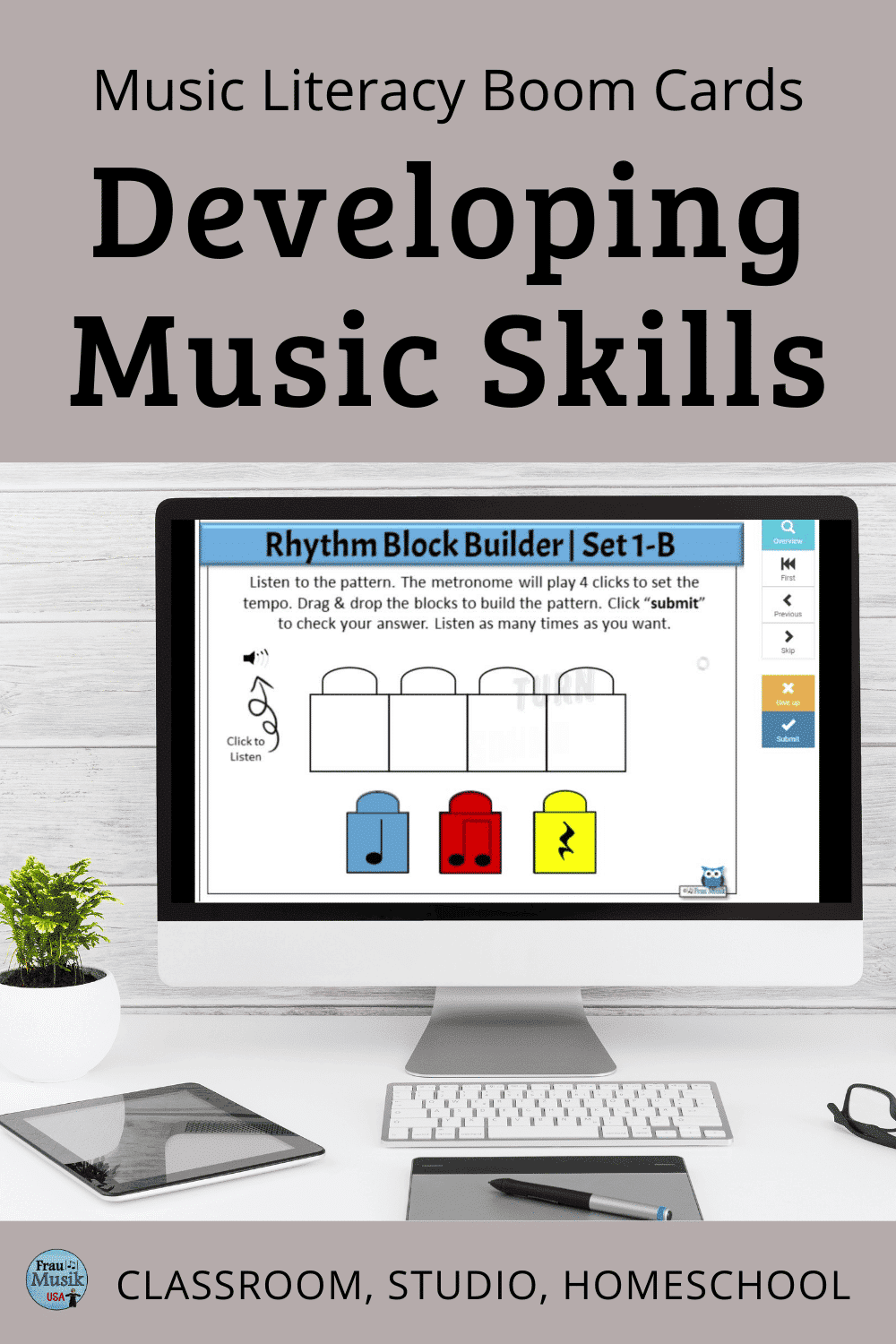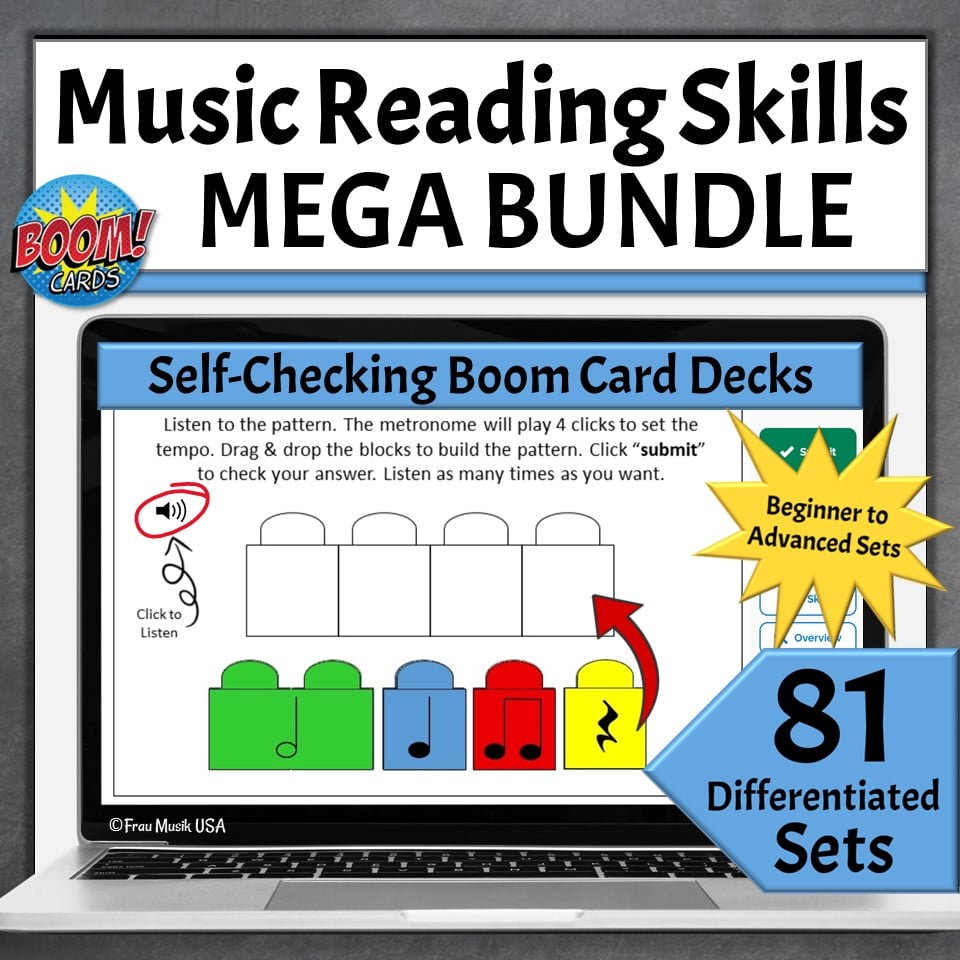How to Develop and Assess Music Reading Skills with Boom Cards
Music Literacy Boom Cards are a valuable addition to your music lesson plans providing FUN authentic assessment of music reading skills.
Some of the links on our site are affiliate links. If you click on a link and make a purchase, we may earn a small commission.
Do Boom Cards teach and reinforce real music reading skills? Absolutely! Our Music Literacy Boom Cards series follows a methodical approach, much like instrumental method books.
Because our bundles are sequential and each set builds upon the last, many of these activities extend beyond the elementary grades and into middle and high school. Many are even helpful for adult beginners.
Boom Cards are perfect for the music classroom, private studio, or homeschool. They are self-checking and provide students with instant feedback. Boom Cards are an important addition to a well-rounded music program.

What’s in this post? Click to open the Table of Contents
Develop a Well-Rounded Music Literacy Program
that Includes a Variety of Fun Activities
Sequential Steps to Develop Independent Music Readers
Taking an eclectic approach to music education gives students a strong foundation. Blending various teaching methods, styles, and resources helps students develop solid music reading and performance skills.
Using a variety of activities keeps lessons interesting and accommodates different learning styles. This helps students better understand music concepts and build music reading skills. A strong musical “toolbox” gives students a strong musical foundation.
Introduce music elements with simple songs and games.
Step 1: Teach Song-Based Music Literacy Activities and Games
Use simple songs and games to introduce one specific music element at a time and provide adequate repetition. The Kodály Method identifies a sequential pathway to teach young children to read music. It provides a song-based model which may be adapted to meet the needs of any elementary music classroom.
See this post with Fun Sequential Elementary Music Lessons to Develop Music Reading Skills for tips on how to sequence and introduce various elements of music through song-based activities and games.
Step 2: Reinforce Melodic Skills with Solfege Warm Ups
Use your targeted music elements as short, simple warm-up patterns. As with standard warm-ups, modulate through several keys matching the range of your students. This is a simple way to introduce movable Do.
See this post for tips and techniques to Teach Music Literacy Skills Using Vocal Solfege Warm-Ups and learn more about using warm-ups as an integral element of your music reading strategy.
Step 3: Cement Learning with Music Dictation Boom Cards
After introducing and practicing each specific musical element, Boom Cards help students develop independent music reading skills. Our structured rhythmic and melodic dictation sets are perfect for the next step.
Self-checking Boom Cards provide instant feedback, allowing students to listen again and correct their mistakes. The game-like format keeps even reluctant learners engaged. Students can replay each set as many times as they want, which motivates them to improve their scores.
Learning Through Mistakes
When your students make mistakes, require them to listen again and fix their mistakes. Mistakes are a natural part of learning. Correcting mistakes is an important step in developing solid music reading skills.
Step 4: Assess Learning with Music Pattern Identification
Once students have demonstrated proficiency with a Music Dictation Set, they will find the corresponding Music Pattern Identification simple. Using Boom Cards for evaluation provides accurate assessments, makes assessments enjoyable, and helps to build student confidence in their music reading skills.
Steps 3 and 4 Boom Cards Sets are Interchangeable
Dictation is more challenging than identifying a musical pattern. This is why I choose Path 1 as outlined below. Students are “uber-prepared” for assessments and the activities are easy and fun for students.
Different Practice and Assessment Paths
Path 1
- Practice: Dictation Set
- Assess: Pattern Identification Set
Path 2
- Practice: Pattern Identification Set
- Assess: Dictation Set
💡 Or, use Dictation Sets for practice and allow students to submit their best scores as an evaluation.
Where Should I Begin with Music Literacy Boom Cards?
Initially, it may be difficult to know where to begin. But, our Music Literacy Boom Cards are SEQUENTIAL and FLEXIBLE. They’re designed to “meet your students where they are”.
Start at a level where you expect all or most of your students to be successful.
Remember, the first time you teach a new digital activity you are also teaching students how to use the technology. You want your students to have a positive experience and enjoy the process.
Answer These Questions First
Boom Cards may be used MANY different ways to develop and assess students’ music literacy levels. Your approach will depend on several factors.
- How old are your students?
- What are your students’ current music reading levels?
- Are you a 1:1 school with every student having their own device?
- Are you planning on using Boom Cards as centers or stations?
- Do you want to use Boom Cards to deliver whole class lessons?
- Will you assign Boom Cards as activities to be completed outside of class?
Consider Differentiation Options
Sequential Music Literacy Boom Cards Bundles make differentiation easy.
- You have the option to assign students different sets, OR
- Assign all students a sequential Boom Cards series and allow them to work at their own pace. This is a good way to challenge students taking private lessons.
Take a peek at the suggested progression and each sequential series below. Then do a quick informal observational assessment to determine where your students should start in this sequence. Students may repeat sets when needed.
Suggested Boom Cards Sequence
Beginning Music Readers – Lay the foundation for your beginning musicians with the following simple sets.
- Identify Same/Different Patterns (Free)
- Identify Higher/Lower on the Staff (Free)
- Aurally Identify Melodic Direction (Free)
- Music Staff Skills Video Lessons
Targeted Music Elements – Each bundle below includes a sequential progression of 7-8 sets. The Primer Set in each bundle is FREE.
Click on each bundle and choose the set(s) that match the music elements your students are learning.
- Rhythmic Dictation Bundle – 8 Sequential Sets
- Identify Rhythmic Pattern – 7 Sequential Sets
- Melodic Dictation Key of C – 7 Sequential Sets
- Melodic Dictation Key of F – 7 Sequential Sets
- Melodic Dictation Key of G – 7 Sequential Sets
- Identify Melodic Patterns Key of C – 7 Sequential Sets
- Identify Melodic Patterns Key of F – 7 Sequential Sets
- Identify Melodic Patterns Key of G – 7 Sequential Sets
Note Names – Integrate Treble Clef and Bass Clef Note Names as they fit into your established curriculum.
- Treble Clef Note Names – 6 Scaffolded Sets
- Bass Clef Note Names – 6 Scaffolded Sets
*As mentioned earlier, you may decide to teach the Music Dictation sets first and then the Music Pattern Identification sets or vice versa. I recommend beginning with Musical Pattern Identification sets.
🎶 A Note About Various Keys
The order in which you present different keys of Melodic Boom Cards sets will vary according to the level of your students.
- If young students are not yet reading ledger lines, begin with selected pitch sets in the Key of F.
- Then, teach the same selected pitch sets in the Key of G.
- Teach the Key of C pitch sets when students are ready to read ledger lines.
Teaching movable Do helps to prepare students for upper-level music programs and beyond. Create life-long musicians.
Your Action Step – Take a Free Set for a “Test Drive”
Take a minute and scan these Free Music Literacy Boom Cards. Choose one of these activities that best meets the needs of your students right now.
- Set up a FREE teacher account at Boom Learning (affiliate link).
- Choose one of our FREE sets and add it to your Boom Library.
- “Play” through the set in Preview Mode as if you were a student.
- Give Boom Cards a test drive with your students.
Music Literacy Boom Cards are Versatile Tools
Music Boom Cards are versatile tools and there are many Innovative Ways to Use Boom Cards in your music classroom.
Ways to Use Music Literacy Boom Cards
- Whole-class lessons with all students answering with simple manipulatives.
- Whole-class lessons with all students answering using sign language or signals.
- Centers or stations
- Practice at home.
Digital Tools Can Build Music Reading Skills
Education has entered a new era, and it’s our responsibility as teachers to not only keep up with technology but also to enhance and pioneer new methods of teaching and learning. Music Literacy Boom Cards can serve as important tools for a well-rounded music literacy program, helping us adapt to this evolving educational landscape.
Boom Cards are more than just games; they’re valuable tools that effectively teach music reading skills.
Invest in the Boom Cards Mega Bundle and Save BIG!
All 81 decks of our sequential bundles are included in this Boom Cards Mega Bundle. And, you will save over 35% when you invest in this versatile Mega Bundle.
P.S. Boom Cards aren’t only for the elementary grades. My mom uses them to stay sharp on her sight reading skills.
Bonus: Our Melodic Dictation Sets Match Boomwhackers!
Boomwhackers are incredibly versatile and always a “hit” with kids. Plus, they are budget-friendly. I bought 4 classroom sets but only added the octavator caps on 2 of those sets.
Octavator caps lower the pitch of the tube by one octave which allows you to have 2 full octaves of notes. But, they are VERY hard to get off once you put them on. My recommendation is to leave them on.
Note: Since Boomwhackers are set in the Key of C, the function of the notes will be different in different keys, (in the key of F, F=Do, etc.).
Everything You Need to Know About Using Music Boom Cards
- Free Video Tutorials for Elementary Music Teachers
- Innovative Ways to Use Boom Cards in Music Classes
- How to Use Boom Cards to Develop and Assess Music Reading Skills
- Free Online Music Lessons for Elementary Students – Boom Cards to Build Music Skills
- Complete Guide – How to Use Boom Cards in the Music Classroom
Meet the Author
Terri Lloyd is a former elementary music teacher with over 25 years of experience. She holds a Bachelor of Music, a Master of Science in Education, and a Technology Certificate in Instructional Design.
Terri is active in music education through blogging, presenting and attending workshops, and curriculum development. She serves on the music staff at her church and volunteers for an after-school children’s program. Terri is an active musician in the community, performing in a local Big Band, pit orchestras, and various events.


I am a preschool music teacher. Our elementary music teacher quit unexpectedly. I am stepping in until a new teacher can be hired, which may not be until the 2021 school year. Thank you for these great activities to help me start this journey.
You are VERY welcome Christy. In these unprecedented times, we all need to support each other. Best wishes!